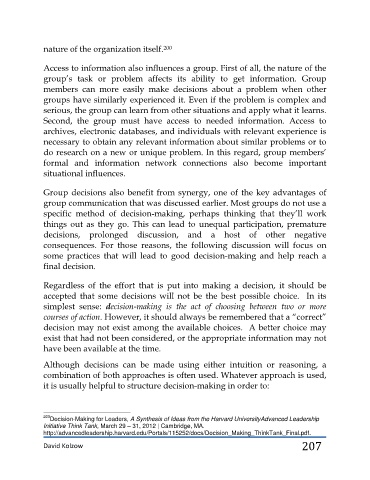Page 207 - 4- Leading_from_Within
P. 207
nature of the organization itself.
200
Access to information also influences a group. First of all, the nature of the
group’s task or problem affects its ability to get information. Group
members can more easily make decisions about a problem when other
groups have similarly experienced it. Even if the problem is complex and
serious, the group can learn from other situations and apply what it learns.
Second, the group must have access to needed information. Access to
archives, electronic databases, and individuals with relevant experience is
necessary to obtain any relevant information about similar problems or to
do research on a new or unique problem. In this regard, group members’
formal and information network connections also become important
situational influences.
Group decisions also benefit from synergy, one of the key advantages of
group communication that was discussed earlier. Most groups do not use a
specific method of decision-making, perhaps thinking that they’ll work
things out as they go. This can lead to unequal participation, premature
decisions, prolonged discussion, and a host of other negative
consequences. For those reasons, the following discussion will focus on
some practices that will lead to good decision-making and help reach a
final decision.
Regardless of the effort that is put into making a decision, it should be
accepted that some decisions will not be the best possible choice. In its
simplest sense: decision-making is the act of choosing between two or more
courses of action. However, it should always be remembered that a “correct”
decision may not exist among the available choices. A better choice may
exist that had not been considered, or the appropriate information may not
have been available at the time.
Although decisions can be made using either intuition or reasoning, a
combination of both approaches is often used. Whatever approach is used,
it is usually helpful to structure decision-making in order to:
200 Decision-Making for Leaders, A Synthesis of Ideas from the Harvard UniversityAdvanced Leadership
Initiative Think Tank, March 29 – 31, 2012 | Cambridge, MA.
http://advancedleadership.harvard.edu/Portals/115252/docs/Decision_Making_ThinkTank_Final.pdf.
David Kolzow 207

